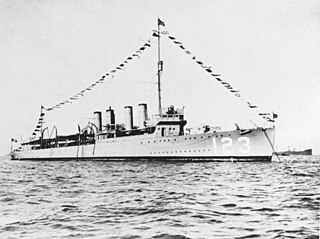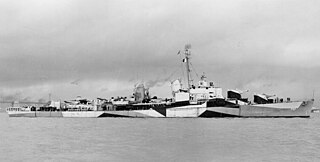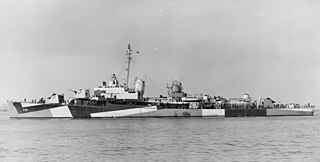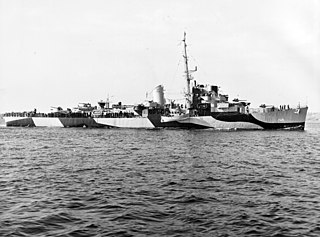
The third USS Farragut (DD-348) was named for Admiral David Glasgow Farragut (1801–1870). She was the lead ship of her class of destroyers in the United States Navy.

USS Gamble (DD–123/DM-15) was a Wickes-class destroyer in the United States Navy during World War I, later converted to a minelayer in World War II.

USS Hale (DD-642), a Fletcher-class destroyer, was the second ship of the United States Navy to be named for Maine Senator Eugene Hale (1836–1918).

The fourth USS Preble (DD-345/DM-20/AG-99) was a United States Navy Clemson-class destroyerin commission from 1920 to 1945. She served in China, including on the Yangtze Patrol, and later saw combat in World War II as a minelayer. She was named for Commodore Edward Preble.

USS Walker (DD-517), a Fletcher-class destroyer, was the second ship of the United States Navy to be named for Admiral John Grimes Walker (1835–1907).

USS Putnam (DD-757), an Allen M. Sumner-class destroyer, was the second ship of the United States Navy to be named for Charles Putnam. She was built and saw action in the Pacific during World War II. She was laid down on 11 July 1943 by Bethlehem Steel Co., Shipbuilding Division, San Francisco, California and launched on 26 March 1944; sponsored by Mrs. Doana Putnam Wheeler. The ship was commissioned on 12 October 1944. Cdr. Frederick V. H. Hilles was in command.

USS Willard Keith (DD-775), an Allen M. Sumner-class destroyer, is currently the only completed ship of the United States Navy ever named for Willard Keith, a United States Marine Corps captain who died in combat during the campaign for Guadalcanal. He was awarded the Navy Cross for his actions.

The second USS Conyngham (DD-371) was a Mahan-class destroyer used in the United States Navy before and during World War II. She was named after Gustavus Conyngham.

USS Walton (DE-361) was a John C. Butler-class destroyer escort in the United States Navy. It was named after Merrit Cecil Walton, a Marine Corps platoon sergeant with the U.S. 1st Marine Division, who died on Gavutu during the Battle of Guadalcanal and was posthumously awarded the Navy Cross for "extraordinary heroism".

USS Darby (DE-218) was a Buckley-class destroyer escort in service with the United States Navy from 1943 to 1947 and from 1950 to 1968. She was sunk as a target in 1970.

USS Huse (DE-145) was a U.S. Navy destroyer escort launched by Consolidated Steel Corp., Orange, Texas on 23 March 1943, during World War II. The ship was sponsored by Mrs. L. M. Humrichouse, daughter of Admiral Harry McLaren Pinckney Huse, whom the ship was named after and commissioned on 30 August 1943.

USS Amick (DE-168) was a Cannon-class destroyer escort built for the United States Navy during World War II. She served in the Atlantic Ocean and then the Pacific Ocean and provided escort service against submarine and air attack for Navy vessels and convoys.

USS Tills (DE-748) was a Cannon-class destroyer escort in service with the United States Navy from 1944 to 1946 and from 1950 to 1968. She was sunk as a target in 1969.

USS Roberts (DE-749) was a Cannon-class destroyer escort in service with the United States Navy from 1943 to 1968. She was later sunk as a target in 1971.

USS Earl K. Olsen (DE-765) was a Cannon-class destroyer escort in service with the United States Navy from 1944 to 1946 and from 1950 to 1958. She was sold for scrapping in 1973.

USS Howard D. Crow (DE-252) was an Edsall-class destroyer escort built for the U.S. Navy during World War II. She served in the Atlantic Ocean the Pacific Ocean and provided destroyer escort protection against submarine and air attack for Navy vessels and convoys.

USS Raymond (DE-341) was a John C. Butler-class destroyer escort acquired by the U.S. Navy during World War II. The purpose of the destroyer escort was primarily to escort and protect ships in convoy, in addition to other tasks as assigned, such as patrol or radar picket. Post-war, she returned home with five battle stars to her credit, including credit for her striking a Japanese cruiser with her 5-inch (127 mm) guns during the Battle off Samar. The destroyer escort was named for Reginald Marbury Raymond, who was killed by enemy gunfire on 30 April 1943 aboard USS Scorpion.

USS Melvin R. Nawman (DE-416) was a John C. Butler-class destroyer escort in service with the United States Navy from 1944 to 1946. She was recommissioned from 1951 to 1960 and finally sold for scrap in 1973.

USS Loeser was a Buckley-class destroyer escort of the United States Navy, named in honor of Lieutenant Commander Arthur E. Loeser (1903–1942).

USS Ruchamkin (APD-89), ex-DE-228, later LPR-89, was a United States Navy high-speed transport in commission from 1945 to 1946, from 1951 to 1957, and from 1961 to 1969. She subsequently served as ARC Córdoba in the Colombian Navy, until 1980; although scrapped, her hull and superstructure were re-erected in a leisure park near Bogotá.




















